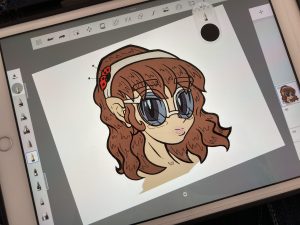
Have you ever wondered if digital art is real art?
I used to wonder if digital art was “real” art. It felt so different from what I grew up with (yes, I’m showing my age as an eighties child!) and didn’t align with the traditional art techniques I studied. How could something so new and unfamiliar compare to the rich history of thousands of years of art?
But as my business grew, as I hired more staff, and as my customers influenced what we taught, my perspective shifted rapidly.
At our studio, we are deeply committed to helping the next generation adapt to the future. You’ve heard us emphasize how creative pursuits shape our brains to be problem solvers, innovators, and changemakers imperative to the future. So, how could we ignore the importance of digital art and it’s obvious place in our future in this mission?
The future of digital art holds unique opportunities and possibilities that differ significantly from traditional art.
One of the most exciting aspects is the potential for interactivity and immersive experiences. Through technologies like augmented reality (AR) and virtual reality (VR), digital art allows viewers to engage with art in dynamic and transformative ways, making it more accessible and engaging than ever before.
Digital platforms also enable artists to collaborate with others worldwide, sharing ideas and creating works collectively. This global community helps art evolve and develop a more diverse and culturally rich landscape of creative ideas. Unlike traditional art, digital art can be reproduced infinitely without losing quality. This allows for widespread distribution, making art more accessible to a global audience – meaning more people can enjoy it!
Better accessibility is another benefit of digital art. Anyone with access to digital tools can create and view digital art, breaking down barriers related to physical location, financial resources, and physical abilities. Being so inclusive and accessible creates a fairer community, full of diverse and interesting artists and art lovers!
Add to all that, digital art can be more environmentally friendly compared to traditional art forms that require physical materials, aligning with the increasing importance of eco-friendly practices.
And finally one of the most important aspects for our children is its seamless integration with various media and technologies, including video games, animation, and film. It opens new career paths and creative possibilities, blending art with entertainment and technology. And there will be so many jobs in the near future that rely on our children being equipped with some form of digital knowledge.
Learning digital art equips children and aspiring artists with technical skills relevant to so many modern industries. It prepares them for future careers in a digitally-driven world, where technology and creativity are certainly linked. Digital art represents the collaboration of creativity and technology, offering us a future rich with innovation, accessibility, and new possibilities that traditional art alone cannot provide. By teaching our children digital art, we give them the skills needed to thrive in an ever-evolving artistic landscape.

